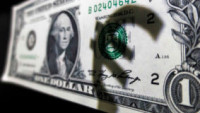 European markets had a broadly positive day yesterday, helped by a strong start for US markets, driven primarily by the Nasdaq, which was up by 2% at one point, however these gains reversed in the last hour of US trading, pulling the Nasdaq 100 below its 200-day MA, as it closed at a new three month low.
European markets had a broadly positive day yesterday, helped by a strong start for US markets, driven primarily by the Nasdaq, which was up by 2% at one point, however these gains reversed in the last hour of US trading, pulling the Nasdaq 100 below its 200-day MA, as it closed at a new three month low.
Investors couldn’t even blame a rise in yields with US treasuries finishing the day higher, thus pulling yields lower for the second day in succession.
The inability of US markets to hold onto yesterday’s move higher is a worry and could well indicate the potential for further losses in the coming days.
With the stock market selling off, the US dollar also underwent a late turnaround, rallying back to its highs for the week, pulling the euro down to a one week low.
Yesterday’s late US sell off looks set to prompt a sharply lower open for markets here in Europe later today, after Asia markets followed suit with the Nikkei also sliding to a 3-month low.
On the data front we have the latest UK retail sales numbers for December, and the bar here is likely to be a low one, given the Plan B restrictions which were implemented mid-month are likely to act as a drag.
It’s been a difficult year for the UK consumer, after a strong performance in April, UK retail sales spending ended up being quite subdued over the rest of the year, as consumers adopted a cautious stance to their spending over the summer months.
With warnings about supply chain disruptions in the leadup to Christmas, due to the prevalence of the Delta variant across the world, the word started to go out at the end of Q3 for consumers to get their shopping in early to avoid disappointment.
These warnings were heeded given the rebounds seen in UK consumer spending in October and November, which saw retail sales rise by 1.1% and 2% respectively.
This pace looks likely to slow in today’s December numbers for several reasons. Firstly, the implementation of the UK governments Plan B restrictions, secondly, we had self-isolation rules tempering consumer behaviour in the lead up to Christmas, notwithstanding a sharp rise in inflation during the month, to an annualised 5.4% with food, clothing and energy driving most of the rise.
Pubs and hospitality will also have been hit hard as consumers stayed at home to ensure they could spend Christmas with their families, less they catch the virus and have to isolate themselves.
Supermarket food sales are likely to have been a strong point as people get together to enjoy the Christmas, they didn’t have last year, however demand is still likely to have been hit with expectations of a decline of -0.8% excluding fuel.
This morning’s Gfk consumer confidence numbers for January also slipped back on the back of the increase in headline inflation, falling to -19, from -15 in December and an 11 month low.
EUR/USD – the inability to get back above the 1.1380 level earlier this week has seen the euro slide back, as we look to retest the 1.1280 area where we have trend line support from the recent lows. A move below 1.1280 reopens the November lows at 1.1195.
GBP/USD – finding support at the 1.3570 area, but needs to move back above the 1.3670 area to retest the 200-day MA and 1.3750 area. A move below 1.3570 opens up the risk of a move back towards 1.3480, and even 1.3420. We need to break above 1.3750 to signal further gains towards 1.3830 initially.
EUR/GBP – continues to drift lower, with the next support at the 0.8280 area and the 2020 lows. Only a move through 0.8380 targets 0.8420.
USD/JPY – could well retest the cloud support at 113.50 which we saw at the end of last week. We need to move back above 115.30 to retarget the recent highs above 116.00. A move below 113.50 opens up the 112.80 area.












